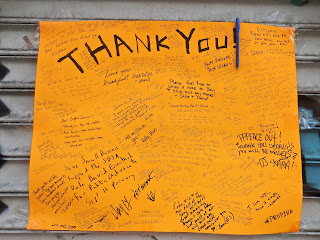These promises of privacy are repeated on banners that circle Extell's One Manhattan Square on the Lower East Side, the latest luxury monstrosity to vandalize our skyline and bully its way into our low-rise neighborhoods. (There will also be a private golf simulator, a private pet spa, a private fitness complex, a private squash and basketball court, and an entire acre of private gardens.)

With so much private space, why venture out of the complex at all? Why engage with city life? The insistence on privacy and the turning away from the street exemplify the suburban mentality come to the city in the 2000s.
One resident of a luxury building loaded with suburban amenities told The Observer in 2008, “Everything's always convenient, always safe, always clean. You don't have to worry about gross things. Like mice! And creepy things like that." Said another, "It sometimes feels like I'm not in New York when I'm in the building... It's trying to have things that a suburban housing complex would--everything at your fingertips, where you don't have to leave [the building] much if you don't want.”
As Sarah Schulman has noted, “They came not to be citified, but rather to change cities into places they could recognize and dominate.”

This process of domination has just begun.
Under the FDR, along the East River Esplanade, someone has taped several flyers from One Manhattan Square, saying: "Join us for weekly complimentary cross fit classes." They are posted all over the spot used by local Chinese people for Tai Chi and other exercise.
It's clearly some kind of tool for selling more condos, but we have to ask: Why, when the people of One Manhattan have so much private space, do they also need to expand into the public space?

I was recently watching the 1979 movie "Breaking Away." It's about conflict between working class townie kids and upper class college kids. On hot days, the townies swim in the quarries where their fathers once cut stone. When the college kids go to swim at the quarry, one of the townies gets angry and says, "They've got indoor pools and outdoor pools on the campus, but they still got to come here!"
One Manhattan has a private spa, a private fitness complex, and an acre of private gardens, but they still have to use the space long enjoyed by the lower income local people.
It doesn't matter if the cross fit class doesn't happen at the same time as the Tai Chi sessions. It doesn't matter that it's free for anyone to join. It is quite clear who the cross fit classes are for. Just look at the people on the flyer.

Recently I was introduced to the concept of "ontological white expansiveness." Shannon Sullivan writes, "As ontologically expansive, white people tend to act and think as if all spaces—whether geographical, psychical, linguistic, economic, spiritual, bodily, or otherwise—are or should be available for them to move in and out of as they wish. Ontological expansiveness is a particular co-constitutive relationship between self and environment in which the self assumes that it can and should have totally mastery over its environment."
I would add that it's not only whiteness, but also the power of class that convinces people that the whole world is for them. Try making this argument to the people who benefit from that expansiveness. They will often tell you that this is public space and "We have a right to be there." They might even say, "We're integrating this neighborhood." And they'll use language like, "Everyone is welcome here."
But all of that covers up what's really going on--the semi-privatization of our public space, and the turning of public spaces into amenities for luxury developments (like we've seen at Astor Place).

The thousands of new people who will flood in to this neighborhood are already changing the East River Esplanade.
More upscaling is coming.

The city just installed a ferry landing nearby. It is an absolute eyesore, blocking formerly uplifting views of the harbor as you walk or bike downtown. But as City Realty pointed out, "Residents of the Lower East Side apartments for sale at One Manhattan Square will have access to a brand-new stop on the NYC Ferry at Corlears Hook."
Who is the ferry meant for?

And, of course, the whole gritty, open esplanade is being renovated -- better to fit the needs and aesthetics of the condo developers and their clients.
More mega-towers are coming. Activists are fighting them.
When the towers come, they will bring more people who don't want to engage with the city as it is. They will emerge from their private pleasure gardens and they will expand into the public space, only to alter it to their taste. And it will be too late to fight it.














































